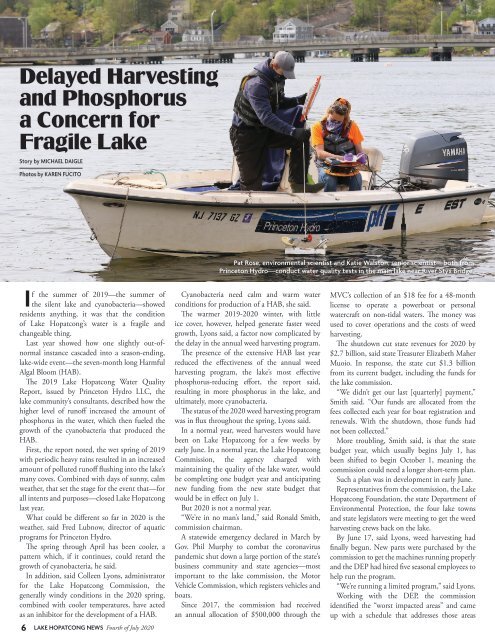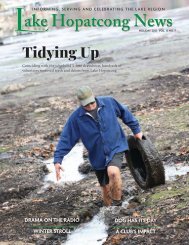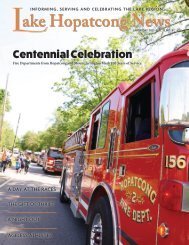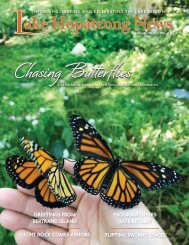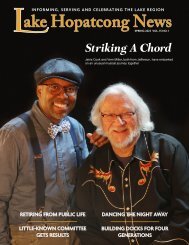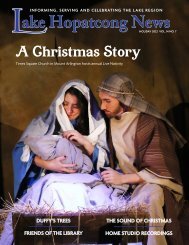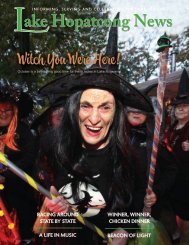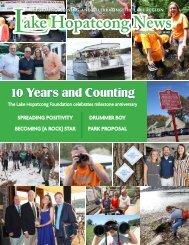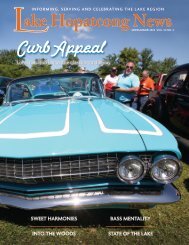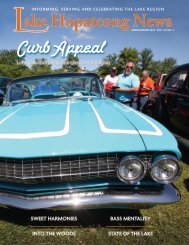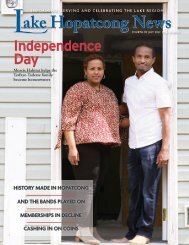Fourth of July Issue
Another issue of Lake Hopatcong News is here! Read the story about solar projects in Hopatcong and Jefferson. Or the profile on Ledgewood's Bob Behrent, who has become somewhat of an expert on the area's eagle population. Or, read writer Melissa Summer's account of navigating home confinement with her husband and three kids. And, don't forget to check out food columnist Barbara Simmon's latest recipe. Our eclectic collection of stories is guaranteed to keep you entertained for hours.
Another issue of Lake Hopatcong News is here! Read the story about solar projects in Hopatcong and Jefferson. Or the profile on Ledgewood's Bob Behrent, who has become somewhat of an expert on the area's eagle population. Or, read writer Melissa Summer's account of navigating home confinement with her husband and three kids. And, don't forget to check out food columnist Barbara Simmon's latest recipe. Our eclectic collection of stories is guaranteed to keep you entertained for hours.
You also want an ePaper? Increase the reach of your titles
YUMPU automatically turns print PDFs into web optimized ePapers that Google loves.
Delayed Harvesting<br />
and Phosphorus<br />
a Concern for<br />
Fragile Lake<br />
Story by MICHAEL DAIGLE<br />
Photos by KAREN FUCITO<br />
Pat Rose, environmental scientist and Katie Walston, senior scientist—both from<br />
Princeton Hydro—conduct water quality tests in the main lake near River Styx Bridge.<br />
If the summer <strong>of</strong> 2019—the summer <strong>of</strong><br />
the silent lake and cyanobacteria—showed<br />
residents anything, it was that the condition<br />
<strong>of</strong> Lake Hopatcong’s water is a fragile and<br />
changeable thing.<br />
Last year showed how one slightly out-<strong>of</strong>normal<br />
instance cascaded into a season-ending,<br />
lake-wide event—the seven-month long Harmful<br />
Algal Bloom (HAB).<br />
The 2019 Lake Hopatcong Water Quality<br />
Report, issued by Princeton Hydro LLC, the<br />
lake community’s consultants, described how the<br />
higher level <strong>of</strong> run<strong>of</strong>f increased the amount <strong>of</strong><br />
phosphorus in the water, which then fueled the<br />
growth <strong>of</strong> the cyanobacteria that produced the<br />
HAB.<br />
First, the report noted, the wet spring <strong>of</strong> 2019<br />
with periodic heavy rains resulted in an increased<br />
amount <strong>of</strong> polluted run<strong>of</strong>f flushing into the lake’s<br />
many coves. Combined with days <strong>of</strong> sunny, calm<br />
weather, that set the stage for the event that—for<br />
all intents and purposes—closed Lake Hopatcong<br />
last year.<br />
What could be different so far in 2020 is the<br />
weather, said Fred Lubnow, director <strong>of</strong> aquatic<br />
programs for Princeton Hydro.<br />
The spring through April has been cooler, a<br />
pattern which, if it continues, could retard the<br />
growth <strong>of</strong> cyanobacteria, he said.<br />
In addition, said Colleen Lyons, administrator<br />
for the Lake Hopatcong Commission, the<br />
generally windy conditions in the 2020 spring,<br />
combined with cooler temperatures, have acted<br />
as an inhibitor for the development <strong>of</strong> a HAB.<br />
6<br />
LAKE HOPATCONG NEWS <strong>Fourth</strong> <strong>of</strong> <strong>July</strong> 2020<br />
Cyanobacteria need calm and warm water<br />
conditions for production <strong>of</strong> a HAB, she said.<br />
The warmer 2019-2020 winter, with little<br />
ice cover, however, helped generate faster weed<br />
growth, Lyons said, a factor now complicated by<br />
the delay in the annual weed harvesting program.<br />
The presence <strong>of</strong> the extensive HAB last year<br />
reduced the effectiveness <strong>of</strong> the annual weed<br />
harvesting program, the lake’s most effective<br />
phosphorus-reducing effort, the report said,<br />
resulting in more phosphorus in the lake, and<br />
ultimately, more cyanobacteria.<br />
The status <strong>of</strong> the 2020 weed harvesting program<br />
was in flux throughout the spring, Lyons said.<br />
In a normal year, weed harvesters would have<br />
been on Lake Hopatcong for a few weeks by<br />
early June. In a normal year, the Lake Hopatcong<br />
Commission, the agency charged with<br />
maintaining the quality <strong>of</strong> the lake water, would<br />
be completing one budget year and anticipating<br />
new funding from the new state budget that<br />
would be in effect on <strong>July</strong> 1.<br />
But 2020 is not a normal year.<br />
“We’re in no man’s land,” said Ronald Smith,<br />
commission chairman.<br />
A statewide emergency declared in March by<br />
Gov. Phil Murphy to combat the coronavirus<br />
pandemic shut down a large portion <strong>of</strong> the state’s<br />
business community and state agencies—most<br />
important to the lake commission, the Motor<br />
Vehicle Commission, which registers vehicles and<br />
boats.<br />
Since 2017, the commission had received<br />
an annual allocation <strong>of</strong> $500,000 through the<br />
MVC’s collection <strong>of</strong> an $18 fee for a 48-month<br />
license to operate a powerboat or personal<br />
watercraft on non-tidal waters. The money was<br />
used to cover operations and the costs <strong>of</strong> weed<br />
harvesting.<br />
The shutdown cut state revenues for 2020 by<br />
$2.7 billion, said state Treasurer Elizabeth Maher<br />
Muoio. In response, the state cut $1.3 billion<br />
from its current budget, including the funds for<br />
the lake commission.<br />
“We didn’t get our last [quarterly] payment,”<br />
Smith said. “Our funds are allocated from the<br />
fees collected each year for boat registration and<br />
renewals. With the shutdown, those funds had<br />
not been collected.”<br />
More troubling, Smith said, is that the state<br />
budget year, which usually begins <strong>July</strong> 1, has<br />
been shifted to begin October 1, meaning the<br />
commission could need a longer short-term plan.<br />
Such a plan was in development in early June.<br />
Representatives from the commission, the Lake<br />
Hopatcong Foundation, the state Department <strong>of</strong><br />
Environmental Protection, the four lake towns<br />
and state legislators were meeting to get the weed<br />
harvesting crews back on the lake.<br />
By June 17, said Lyons, weed harvesting had<br />
finally begun. New parts were purchased by the<br />
commission to get the machines running properly<br />
and the DEP had hired five seasonal employees to<br />
help run the program.<br />
“We’re running a limited program,” said Lyons.<br />
Working with the DEP, the commission<br />
identified the “worst impacted areas” and came<br />
up with a schedule that addresses those areas


